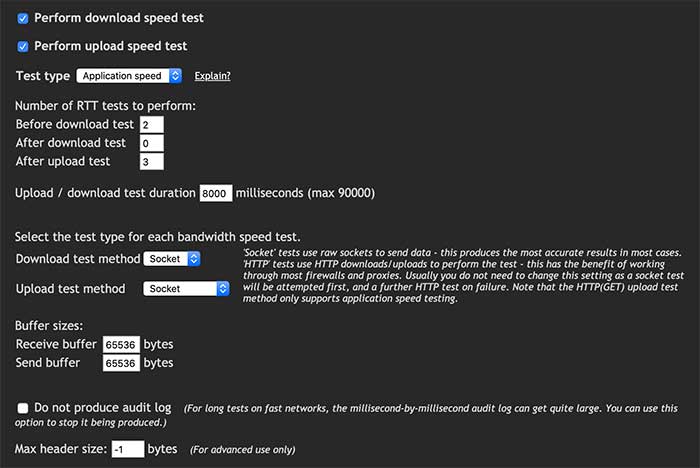Speed Test Configuration

Perform Download test: Select this option to do a download test, i.e. from server to client.
Perform Upload test: Select this option to do an upload test, i.e. from client to server.
Test Type: This selection defines the test method, namely application speed (end-to-end throughput) and capacity speed (bandwidth capacity limit). These measures are entirely different. The explain link in the page will explain more.
Number of RTT tests to perform: This parameter defines the number of round trip time measures to be tested. This is a true TCP trip time not a ping measure which is not as accurate. Trip time is a very important measure for TCP throughput. Configuring multiple trip measures allows the test to assess trip time variance. A high variance is the first indicator of poor connection quality.
Test duration: This parameter defines the amount of time you want the download and upload tests to last. This is defined in milliseconds. The limit is 90 seconds (90,000 milliseconds).
Test Type for each bandwidth speed test: This selection defines the test type, namely, Socket and HTTP. 'Socket' tests use raw sockets to send data - this produces the most accurate tests, especially on connections over 10Mbps. 'HTTP' tests use the HTTP protocol (i.e. standard web server) to perform the test - this has the benefit of working through most firewalls and proxies. Note if a socket test is selected and the socket port is blocked by a firewall then the test will fallover automatically to an HTTP test.
Buffer Sizes: Coming soon.
No Audit Log: For long tests on fast networks the millisecond-by-millisecond audit log can get quite large. You can use this option to stop it being produced.
Max Header Size: This option defines the most HTTP memory to allocate and applies only to HTTP tests. This should not be set under normal conditions.

